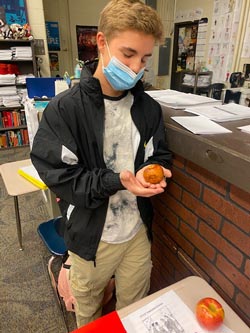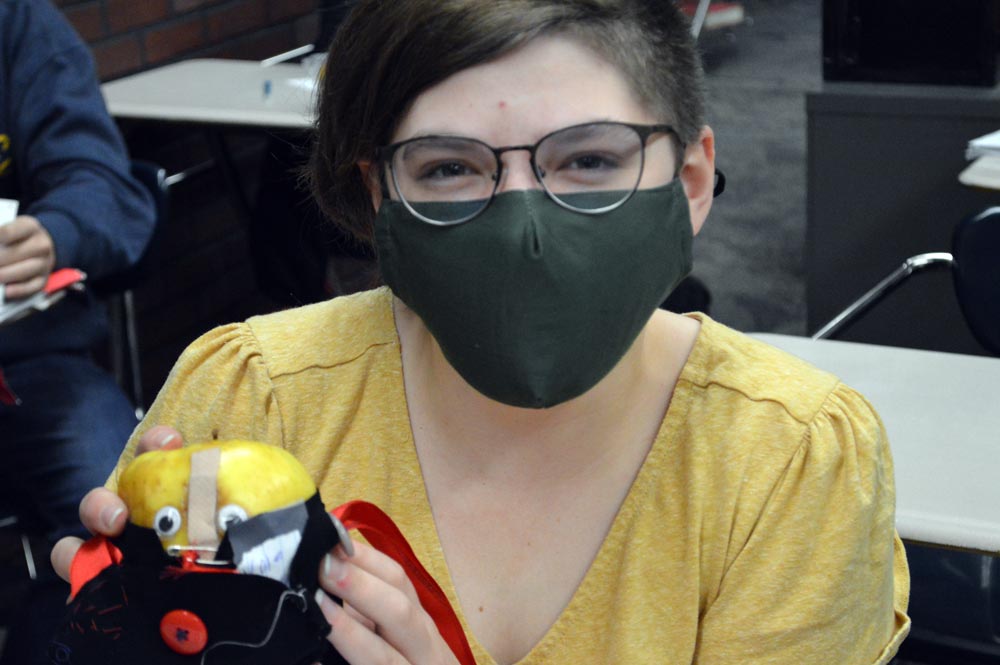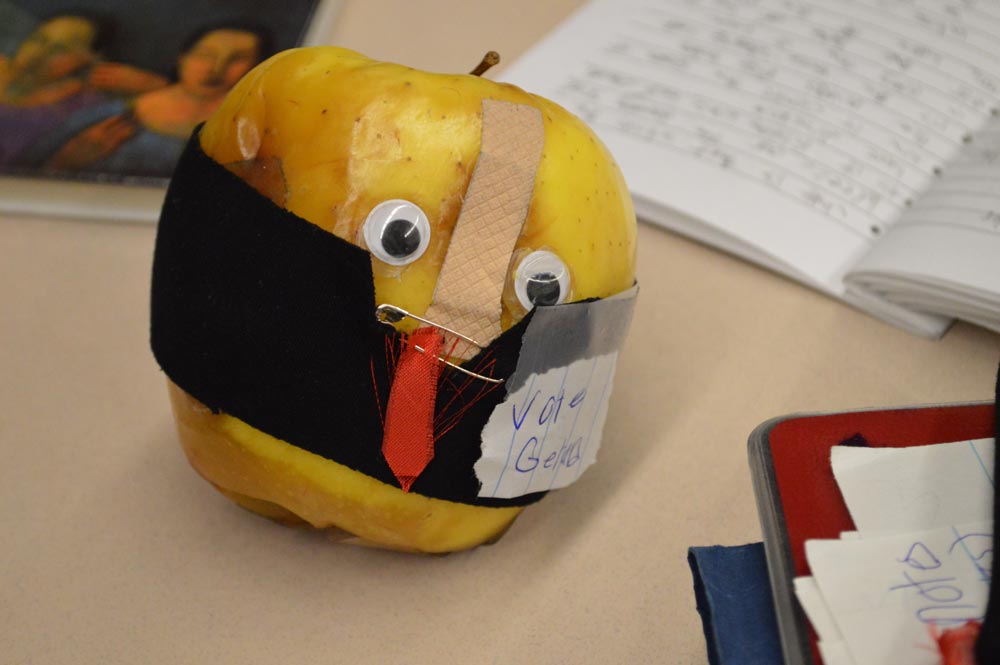Wyoming — There are some bad apples in Wyoming Junior High School’s ninth grade Advanced English class.
But don’t judge them until you hear their stories.
Freshman Symone Gray wrapped her apple, named Martin Van Buren after the eighth U.S. president, in paper towels and plastic. It oozed slightly fermented juice.
“He is in a bad state,” she said with emotion in her voice. “After the incident, he felt really bad and now he lost his memory. He had to be put in memory care, so I’m his caretaker. He keeps on rambling about the incident. It’s getting harder.”
The incident — a string of incidents, actually — made for great creative writing entries in Symone’s journal for her English class, where her classmates were dreaming up other fruit-based stories. She provided a synopsis of Martin’s recent struggles.
“His father got eaten and it traumatized his mother,” she explained. “He was left to take care of his grandpa, but after his grandpa passed away he tried to go find a new life in the big city (the Big Apple), but it went wrong for him. It was just so tough coping with that. He was walking outside in New York City and he got hit by a car.”
Martin was a lump of mushy pulp after all his trials and tribulations. His fellow apples, who also faced drama both real and imaginary, were in similar conditions after six days in their students’ possession. The ninth-graders journalled about their apples five times a day during the weeklong “35 Ways to Babysit an Apple” project in teacher Jeremy Schnotala’s class.
Juicy, Crisp Writing
Schnotola created the project many years ago as a way to spur students’ imaginations when writing poems, stories, autobiographies, songs and other pieces. He decided to put a literary twist on the well-known lesson involving teens babysitting fake babies to learn responsibility.
“I thought, I’m not going to have them carry a baby, because I can’t stand babies, but I will give them an apple and see how that works,” he said.

Each fall, Schnotala picks apples — the more bruised, the better — off the ground at a local orchard. “I try to get them already a little aged so their personalities develop sooner. Part of the thing is writing by showing and not telling, so you want to see a change in the apple anyway.”
Students are then challenged to write about their apple, peppering their writing with vocabulary words and using appositive phrases, participles and fragments. They hone their craft by writing through dialogue, actions, sensory imagery, metaphors and personification.
During the project, students use the novel, “The House on Mango Street” by Sandra Cisneros, as a model for episodic writing and connecting their apple journal entries into a narrative. The final assignment is for students to leave the apple behind and write an autobiography including several episodes from their own life.
“For some weird psychological reason, when you are asked to carry this object with you for a week, it cements this week in your memory,” said Schnotala. “You see things in a different way and you remember things. I have students I taught tens of years ago still email me about the apple experience.”
Planting Story Seeds
Ninth-grader Samantha Gross’ apple, Gerard, ran for president against an apple in another hour. It had been quite a political battle.
“He’s gotten very squishy,” she said. “I’ve put band-aids on him, but he’s starting to leak out.”
She wrote stories and an apple-themed version of the National Anthem in her journal. “Tomorrow will be the end of voting. Hopefully Nevada finally puts in their votes,” Samantha said without cracking a smile.

One desk over from Gerard sat classmate Jones Bolle’s apple, Jenny, which appeared to be closer to sauce than solid. Jenny was smacked over the head with a bottle, Jones explained. “I wrote a poem about it; it was because I caught (classmate) Grace’s apple cheating on Jenny. She was in a fight with Symone’s apple. Grace’s apple, Vendetta, smashed a bottle over Jenny’s head and caused permanent damage, and she is now in the ICU.”
As sad as the situation was for his apple, Jones said it was fun to put that down on the page.
“It’s definitely helped me focus more on using quotes, dialogue and symbolism, and to use more figurative language,” he said.
The final day of the project was spent dissecting what was left of the apples and holding a ceremony to say goodbye through poems and songs. Students could also save their seeds to grow their own apple trees.
Ninth-grader Abby Kramer decided to tape the seeds from her apple, Milo, in her journal, “so he can always be with it.”
“It was kind of a disgusting experience and it also gave us a chance to say goodbye one last time,” she said of the seed autopsy. “It made it real for us in a way, like how you would imagine saying goodbye to a loved one.”















